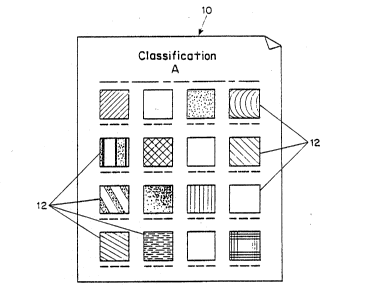Some of the information on this Web page has been provided by external sources. The Government of Canada is not responsible for the accuracy, reliability or currency of the information supplied by external sources. Users wishing to rely upon this information should consult directly with the source of the information. Content provided by external sources is not subject to official languages, privacy and accessibility requirements.
Any discrepancies in the text and image of the Claims and Abstract are due to differing posting times. Text of the Claims and Abstract are posted:
| (12) Patent: | (11) CA 2077677 |
|---|---|
| (54) English Title: | METHOD OF SELECTING PERSONAL COMPATIBLE COLORS |
| (54) French Title: | METHODE DE SELECTION DE COULEURS EN FONCTION DU TEINT CARACTERISTIQUE D'UNE PERSONNE |
| Status: | Deemed expired |
| (51) International Patent Classification (IPC): |
|
|---|---|
| (72) Inventors : |
|
| (73) Owners : |
|
| (71) Applicants : |
|
| (74) Agent: | G. RONALD BELL & ASSOCIATES |
| (74) Associate agent: | |
| (45) Issued: | 1998-08-18 |
| (86) PCT Filing Date: | 1990-03-16 |
| (87) Open to Public Inspection: | 1991-09-17 |
| Examination requested: | 1995-03-23 |
| Availability of licence: | N/A |
| (25) Language of filing: | English |
| Patent Cooperation Treaty (PCT): | Yes |
|---|---|
| (86) PCT Filing Number: | PCT/US1990/001284 |
| (87) International Publication Number: | WO1991/014158 |
| (85) National Entry: | 1992-09-04 |
| (30) Application Priority Data: | None |
|---|
A method for the selection of proper colors (12) for individual wearers depending upon the underlying color of the skin of
the wearer and the intensity therefor. The method includes the steps of providing a group of classifications of color temperature,
preferably four in number, and using a spectrophotometer, or a draping technique of material to determine the color temperatures
of the skin of the user, and a determination of the classification in which those color temperatures fall is made. A predetermined
group of colors (12) are classified within each category, so that upon determination of the proper classification for an individual
user, reference may be made to the proper predetermined group of colors (12) as a guide for appropriate apparel, cosmetic makeup,
or hair tint selection.
Méthode pour la sélection de couleurs propres (12) à des utilisateurs individuels selon la couleur sous-jacente de leur peau et l'intensité qui leur convient. La méthode comprend les étapes suivantes: on établit des classes de températures, de préférence au nombre de quatre, et on utilise un spectrophotomètre ou une technique de drapage du matériel pour déterminer les températures de couleur de la peau de l'utilisateur, et l'on détermine la classe dans laquelle tombent ces températures de couleur. On classe un groupe de couleurs (12) prédéterminé dans chaque catégorie , de sorte que, après avoir déterminé la classe propre à un utilisateur individuel, on peut se référer au groupe de couleurs propres (12) prédéterminé comme guide pour faire un choix approprié de vêtements, de produits cosmétiques ou de teinture de cheveux.
Note: Claims are shown in the official language in which they were submitted.
Note: Descriptions are shown in the official language in which they were submitted.

For a clearer understanding of the status of the application/patent presented on this page, the site Disclaimer , as well as the definitions for Patent , Administrative Status , Maintenance Fee and Payment History should be consulted.
| Title | Date |
|---|---|
| Forecasted Issue Date | 1998-08-18 |
| (86) PCT Filing Date | 1990-03-16 |
| (87) PCT Publication Date | 1991-09-17 |
| (85) National Entry | 1992-09-04 |
| Examination Requested | 1995-03-23 |
| (45) Issued | 1998-08-18 |
| Deemed Expired | 2005-03-16 |
There is no abandonment history.
| Fee Type | Anniversary Year | Due Date | Amount Paid | Paid Date |
|---|---|---|---|---|
| Application Fee | $0.00 | 1992-09-04 | ||
| Maintenance Fee - Application - New Act | 2 | 1992-03-16 | $50.00 | 1992-09-04 |
| Maintenance Fee - Application - New Act | 3 | 1993-03-16 | $50.00 | 1993-03-15 |
| Maintenance Fee - Application - New Act | 4 | 1994-03-16 | $50.00 | 1994-03-15 |
| Maintenance Fee - Application - New Act | 5 | 1995-03-16 | $75.00 | 1995-03-15 |
| Maintenance Fee - Application - New Act | 6 | 1996-03-18 | $75.00 | 1996-02-29 |
| Maintenance Fee - Application - New Act | 7 | 1997-03-17 | $75.00 | 1997-03-05 |
| Registration of a document - section 124 | $100.00 | 1997-04-30 | ||
| Maintenance Fee - Application - New Act | 8 | 1998-03-16 | $150.00 | 1998-02-25 |
| Final Fee | $300.00 | 1998-04-14 | ||
| Maintenance Fee - Patent - New Act | 9 | 1999-03-16 | $75.00 | 1999-03-03 |
| Maintenance Fee - Patent - New Act | 10 | 2000-03-16 | $100.00 | 2000-03-02 |
| Maintenance Fee - Patent - New Act | 11 | 2001-03-16 | $100.00 | 2001-03-05 |
| Maintenance Fee - Patent - New Act | 12 | 2002-03-18 | $300.00 | 2002-03-20 |
| Maintenance Fee - Patent - New Act | 13 | 2003-03-17 | $300.00 | 2003-06-20 |
Note: Records showing the ownership history in alphabetical order.
| Current Owners on Record |
|---|
| CHROMATICS COLOR SCIENCES INTERNATIONAL, INC. |
| Past Owners on Record |
|---|
| MACFARLANE, DARBY S. |